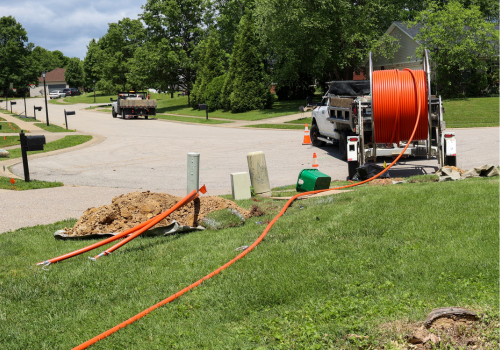The importance of technology to utilities in 2022 can’t be overstated given the challenges of reducing carbon emissions and building more resiliency into networks. In a recent Accenture study 83% of utility executives agree that their organization’s business and technology strategies are becoming inseparable—even indistinguishable. In addition, 88% of utility executives believe that their organization’s ability to generate business value will increasingly be based on the limitations and opportunities of their technology architecture. Here’s a look at how the top tech trends will change the way the utility sector works.
5G
5G—the fifth-generation mobile network, is the new global wireless standard capable of transferring data 10x faster than 4G. But beyond speed, 5G networks can deliver up to 1,000x more capacity than 4G. With greater capacity, many devices can be connected. This is important given that the electric utility industry is moving from centralized to decentralized energy generation. As more renewable energy sources are connected to the grid, the grid becomes more complex to operate.
The low latency of 5G mobile networks also creates new opportunities within utilities for cloud computing. Data can move from smart meters, sensors and other devices, to the cloud, where it can be analyzed and acted upon. According to a 2021 Deloitte survey of networking executives across industries globally, 58% of respondents are already deploying 5G or running pilots. Twenty-six percent of power and utilities industry survey respondents reported that 5G communications technologies are incorporated into their company’s strategy, while 36% plan to incorporate it.
At the New York Power Authority (NYPA), the largest state-owned electric utility in the United States, a private LTE network in being piloted at the Blenheim-Gilboa hydroelectric plant, to help predict and avoiding power and distribution failures. 5G is also being used to support workforce mobility applications and drones.
Smart grids
The nation’s electric grid is a network of transmission lines, substations, transformers and more that transport power from the plant homes and businesses. It includes more than 9,200 electric generating units with more than 1 million megawatts of generating capacity and more than 300,000 miles of transmission lines.
However, it’s not enough to handle increasing demands for electricity. As we move toward electrification in transport, building, and heavy industry sectors, demand for electricity could increase by anywhere from 35% to 90%, according to a 2020 study from the Goldman School of Public Policy at University of California Berkley.
Utilities must constantly monitor supply and demand to avoid damage to power plants and with more renewal energy sources being added to the grid, it becomes even more challenging to keep supply the system in balance. Digital technology that allows for two-way communication between the utility and its customers, along with sensing along the transmission lines, makes the grid “smart.”
Increase resiliency in the grid is needed to handle extreme and frequent weather events. The smart grid needs to be able to integrate clean energy resources like solar and wind and support distributed energy resources, including electric vehicles and distributed solar and energy storage.
The Infrastructure Investment and Jobs Act passed in November 2021 allocates more than $15 billion in direct funding and more than $12 billion in borrowing authority to improve the nation’s grid infrastructure and resiliency. This spending is allocated in fiscal years 2022 to 2026.
According to MarketsandMarkets, the Smart Grid Market will grow to $103.4 billion by 2026 from $43.1 billion in 2021, a compound annual growth rate of 191% during the forecast period.
Smart meters are a key component of the smart grid. Not only the does the meter record the consumption of energy, for billing purposes, it collects information for remote reporting and allows consumers to see and adjust in real time how much energy they are using. Workers no longer need to physically access meters to obtain a reading, allowing for significant cost savings. The information transmitted by smart meters helps utilities better manage their assets, in particular, distributed energy resources such as solar panels or battery storage.
Artificial intelligence
Wherever mounds of data exist, there’s an opportunity to deploy artificial intelligence (AI) to analyze the data and provide insights. AI deploys computers to perform tasks following the same logic of human intelligence.
From improving the inspection of assets and forecasting the energy load to helping manage vegetation and improving customer service, utilities are increasingly finding value in AI and machine learning.
Through the Electric Power Research Institute (EPRI), utilities have investigated the use of drones and AI to improve the inspection of transmission and distribution assets. Unmanned drones equipped with cameras collect thousands of images of conductors, transformers and other equipment which is then analyzed to identify those assets at risk of failure. The method is proving to be faster and safer than traditional manual inspections.
Another application from EPRI seeks to reduce the cost and effectiveness of vegetation maintenance around utility lines - a major expense for utility companies. High spatial resolution remote sensing can be used to proactively manage at-risk trees, with the goal of minimizing costly power outages. Understanding the location and scale of dead and highly drought-stressed trees is also important for the prevention and mitigation of forest fires.
Bidgely, an AI provider, reports working with more than 40 utilities to harness the power of data including Duke Energy, Southern California Gas (SoCalGas), TEPCO, and NV Energy. Bidgely, believes there is a huge opportunity in using personalized data to improve customer engagement at utilities. For example, AI could allow a utility to contact a customer to provide an incentive to charge electric vehicles during off-peak hours, or alert a customer before the end of the period that their energy usage is high, suggesting mitigations. The goal is to provide consumers with highly personalized, actionable and timely information to drive engagement and customer satisfaction.
Net-zero natural gas technology
The U.S. has a goal of zero net emissions across the economy by 2050, and utilities currently produce more emissions than any other sector, accounting for about 40% of emissions. This past year marked the first-time electricity produced with zero emissions from burning natural gas, was delivered onto the grid. In November of 2021, NET Power, developer of the novel Allam-Fetvedt supercritical carbon dioxide (sCO2) power cycle, announced the delivery of electricity onto the ERCOT grid from its 50 MWth test facility in La Porte, Texas.
NET Power’s technology burns natural gas and uses supercritical CO2 to generate electricity while inherently capturing CO2. Net Power’s technology uses a new kind of turbine to burn natural gas in oxygen, rather than the air. The only biproducts are carbon dioxide and water. The water can be frozen out of the mixture and the pure stream of CO₂ can be buried in depleted oil and gas wells or similar geological structures.
NET Power projects have been publicly announced in the United States, Canada, and the United Kingdom. In the U.S., NET Power licensed its technology to developer 8 Rivers Capital LLC, which will work with agriculture giant Archer-Daniels-Midlands Co. to replace some emissions from a coal power plant in Illinois. 8 Rivers is also working on a plant with the Southern Ute Indian Tribe Growth Fund in Colorado. In Canada, Frog Lake First Nation, east of Edmonton, partnered with Kanata Clean Power and Climate Technologies to use NET Power's patented technology to build the first net-zero natural gas-powered electricity plant in Canada. The power plant will generate 300 megawatts of electricity, and produce water for 15,000 households. Construction will begin in 2023 and the plant is expected to be online in 2025. NET Power is co-owned by Exelon Generation, McDermott International, 8 Rivers Capital, and Oxy Low Carbon Ventures (OLCV), a subsidiary of Occidental.
Subscribe to The Utility Expo monthly newsletter to receive more industry insights like this.












